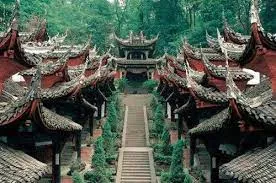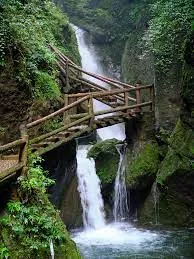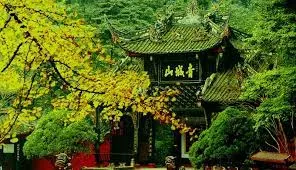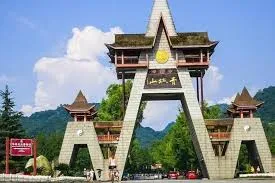
Mount Qingcheng
Delhi
Mount Qingcheng Itinerary
Day 1: Arrival in Chengdu and Transfer to Mount Qingcheng Morning:
Arrive in Chengdu, the capital of Sichuan Province, either by plane or train. Midday: Take a private transfer or public transportation from Chengdu to Mount Qingcheng, located approximately 70 kilometers away. The journey takes about 1.5 to 2 hours. Afternoon: Check into your accommodation near Mount Qingcheng and enjoy a relaxing afternoon exploring the surrounding area. You can stroll through the quaint streets, sample local snacks, or visit nearby attractions. Evening: Enjoy dinner at a local restaurant and rest in preparation for your adventure on Mount Qingcheng.
Day 2: Exploring Mount Qingcheng Morning:
Begin your exploration of Mount Qingcheng, one of the birthplaces of Taoism and a UNESCO World Heritage Site. Start with a visit to the Front Mountain (Qingchengshan), which is known for its lush forests, ancient temples, and serene atmosphere. Midday: Enjoy lunch at a mountain restaurant, where you can savor delicious Sichuan cuisine while taking in panoramic views of the surrounding landscape. Afternoon: Continue your ascent of Mount Qingcheng, exploring the various temples, pavilions, and scenic spots along the way. Visit the Shangqing Palace, Laojun Pavilion, and Tianshi Cave, among other attractions. Evening: Descend from the mountain and return to your accommodation. Relax and unwind, perhaps with a traditional hot spring bath to soothe your muscles after a day of hiking.
Day 3: Back Mountain Exploration Morning:
Today, explore the Back Mountain (Hou Shan) of Mount Qingcheng, which is less visited but equally picturesque. Take a cable car or hike to the summit, where you'll find stunning views and fewer crowds. Midday: Have lunch at one of the mountain restaurants, enjoying local specialties and refreshing beverages. Afternoon: Explore the Back Mountain's attractions, including the Jianfu Palace, Shangqing Temple, and Shangshiyan Scenic Area. Take leisurely walks along forested trails and immerse yourself in the tranquility of nature. Evening: Descend from the mountain and return to your accommodation. Spend the evening at leisure, perhaps enjoying a traditional tea ceremony or cultural performance.
Day 4: Departure from Mount Qingcheng Morning:
Enjoy a leisurely breakfast at your accommodation, savoring your last moments in the serene surroundings of Mount Qingcheng. Midday: Check out of your accommodation and depart from Mount Qingcheng. You can either return to Chengdu to catch your onward flight or continue your journey to other destinations in Sichuan. Afternoon: If time permits, make a stop at nearby attractions such as the Dujiangyan Irrigation System or the Panda Base in Chengdu for a memorable end to your trip. Evening: Depart from Chengdu, reflecting on your memorable experiences on Mount Qingcheng and in the beautiful province of Sichuan.
Our Tour Details
-
Pick-up and DropDelhi
-
Duration3N/4D
-
Starting Price₹/-
Frequently asked Questions:
Mount Qingcheng, also known as Qingchengshan, has an elevation of 1,260 meters (4,134 feet) and is a sacred Taoist mountain in Sichuan Province, China.
Mount Qingcheng is located in the Dujiangyan City, approximately 68 kilometers northwest of Chengdu, the capital of Sichuan Province.
Yes, Mount Qingcheng is considered one of the birthplaces of Taoism. It is known for its Taoist temples, ancient philosophy, and is recognized as a UNESCO World Heritage Site.
Mount Qingcheng has 36 peaks, and the main peak is called Laojunshan. The mountain is divided into two parts: the Front Mountain and the Back Mountain.
Yes, Mount Qingcheng offers various hiking trails for visitors. The Front Mountain is known for its cultural and historical sites, while the Back Mountain is more secluded and surrounded by lush greenery.
Yes, there is a cable car that takes visitors to the summit of Mount Qingcheng, providing a convenient way to enjoy panoramic views of the surrounding landscapes.
Yes, Mount Qingcheng is closely associated with the Dujiangyan Irrigation System, an ancient engineering marvel designed to control flooding in the Chengdu Plain. The system is recognized as a UNESCO World Heritage Site.
The best time to visit Mount Qingcheng is during the spring and autumn months (April to October) when the weather is pleasant, and the mountain is adorned with blooming flowers or colorful foliage.
Yes, Mount Qingcheng is home to several Taoist temples, including the Shangqing Temple and the Jianfu Palace. These temples showcase traditional Chinese architecture and are places of pilgrimage for Taoists.
Yes, there are accommodations available on Mount Qingcheng for visitors who wish to stay overnight. Staying on the mountain provides a unique experience and the opportunity to explore the serene atmosphere during different times of the day.





